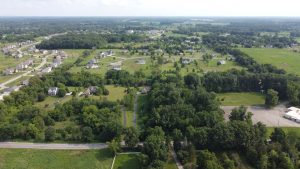
Early in the recorded history of Dexter Township are reports of several Native American villages of the Anishinaabe people. The Anishinaabe tribes living in the area included the Ojibwa, Ottawa, Huron, and Pottawatomi. The proximity to the Huron River and Mill Creek made the area desirable for trade and tribal gatherings. Early maps of the area show Indigenous trails in Dexter Township along the Huron River and what is now Island Lake Rd.
The first colonial settlers came mainly from New York and made their first settlements in 1825, on the northeast fractional ¼ of section 36. Samuel W. Dexter purchased the east half of section 12 where the Dover Mills were later located.
The first town meeting of the original Dexter Township was held in the home of Judge Dexter, May 28, 1827.
Due to errors in surveying the township, the northern portions of sections contained less than three-quarters of the prescribed quota of land. The western area of the sections fell short by as much as fifty to sixty-five acres per section.
The early settler began farming as soon as he purchased his land. Wheat was the leading crop for some time, and nearly every farm produced some corn, barley, oats and clover.
Apples were grown in all parts of the township. The farms in the North Lake area succeeded in producing the best and greatest varieties of fruit of any part of the township.
Up to 1832 the entire western half of Washtenaw County, plus parts of Jackson and Livingston Counties, were governed by the original Township of Dexter. It was comprised of land that would later become Dexter, Scio, Webster, Lima, Freedom, Bridgewater, Manchester, Sharon, Sylvan, and Lyndon Townships.
A new Township Hall was erected at 6880 Dexter-Pinckney Road in 1970. The frame building used as a Town Hall for many years, located across from the first Catholic cemetery on Quigley Road at the corner of Dexter-Townhall Road, was then moved to a site on Territorial Road and converted into a residence.
The North Lake Methodist Episcopal Church was founded in 1836.
A Catholic Church was begun about 1840 and was located on the corner of Dexter Town Hall Road and Quigley Road in section 21 where the old Catholic cemetery can still be seen today. The members were very active until the church burned in 1854. It was then decided to rebuild within the Village of Dexter.
There were six whole school districts located in the township. The old Smith School, once located on a sandy rise of ground on the William Smith farm, was later rebuilt across the road on what is now Territorial Road. One school was located on the old Gallagher farm at the intersection of Territorial Road and Huron River Drive. There were three schools located on the old Plank Road (now Island Lake Road). For some time a school was located on Pinckney Road north of Territorial Road.
Located on what is now Pinckney Road near the intersection of Territorial Road, is the Hudson Mills Cemetery which some of the early settlers of the township are buried. Other cemeteries in the township are located near Four Mile Lake on Lima Center Road and on Riker Road near the North Lake Church.
For more information regarding the Hudson Mill Cemetery please contact the Dexter Area Historical Museum at:
3443 Inverness Street, Dexter, MI 48130
(734) 426-2519
The original Thomas Birkett farm–section 1 through 12–included some 425 acres. Here Dover Mills was located and here he built his beautiful, large home. In later years, Birkett Newkirk encourages his grandfather, Thomas Birkett, to donate some of his land near Peach Mountain to the Y.M.C.A. Much later Peach Mountain was given to the State of Michigan with the understanding that the University Of Michigan would use this land for its observatory.
There are many lakes in Dexter Township. Of Dexter Township’s 33 square mile area, approximately 2.6 square miles (7.8%) is covered by lakes and the Huron River. The lakes completely in Dexter Township include Crooked Lake, Pickerel Lake, Losee Lake, Little Portage Lake, West Lake, Riker Lake, and Dead Lake. Additionally, Halfmoon Lake, Hi-Land Lake, Silver Lake, Portage Lake, Four Mile Lake, and North Lake are partially in the Township. These lakes as well as the Huron River are used for passive and active recreational purposes.